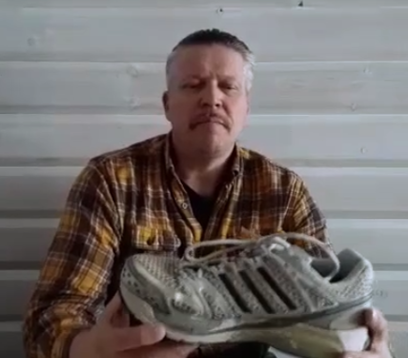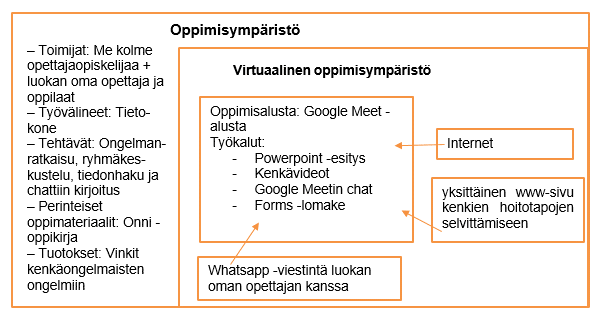Theory behind our teaching experiment
The Finnish national core curriculum (FNCC, 2014, p. 17) is based on a concept of learning in which the student is an active operator who learns to solve problems and sets goals both individually and in collaboration with others. Like the FNCC, our learning experiment was built on a constructive concept of learning, where students operate as active members of the group and interact with each other to solve the questions presented during the classes. As Siljander says (2015, p. 216), the constructive concept of learning can be divided into either individual or social approaches. According to Kauppila (2007, p. 48) the social approach enhances the construction of learning in collaboration with others and (2007, p. 76) gives the teacher a possibility to improve students´ meaningful learning and helps developing their inner motivation.
In our teaching experiment we utilized problem-based learning which, according to Ilomäki (2012, p. 106), is a pedagogical model where students develop their learning by discussing among themselves pre-arranged problems. Before the lessons we compiled the problems into video format, and during the lessons the students searched for the solutions in small groups. Ilomäki (2012, p. 109) says that the teacher´s role in problem-based teaching is to plan the content of the problematic situation and be the expert from whom students can seek advice. Another expert in our teaching was the shoemaker, who specializes in shoe care. We also used reverse teaching, which means that students get acquainted with the theory at home and do assignments at school (Toivola, Peura & Humaloja, 2017, p. 20).
Development of the teaching experiment
Traditionally, shoe care teaches that students should take care of either their own shoes as well as school shoes and, at the same time, learn to use various materials and tools for shoe care. We decided to come up with something new and different for our shoe care teaching. Since we wanted to use problem-based learning as the background theory for our lessons, we started to develop shoe care problems. We created problem situations that the students might face in their daily lives because, according to Perry (2020, p. 139), in home economics lessons it is good to focus on the care of the kind of shoes that the students themselves wear.
We ended up filming video material for the lessons. The videos acted as “sensitive material” of people who have different kinds of problems with shoe care. The topics of the videos were: dirty sneakers, broken heel, protection of new shoes and leather shoe care. We also wanted to bring a bit of humour to the problems; this was achieved by dramatizing the problems and editing the videos so that the voices and pictures of the people were blurred and names changed. In addition, the actual shoes seen in the videos were available in the classroom so that the students could examine them while solving the problems presented in the videos. The shoes had been treated in such a way that they corresponded to the stories and the emerged problems seen in the videos.

Picture 1. Shoemaker introducing sneaker care
For our learning experiment, we created a shoemaker´s helpline where an actual shoemaker gave answers to the people with shoe problems. The aim of our lesson was that the students would learn how to properly take care of different kinds of shoes. The shoemaker acted as an expert of shoe care, who gave his solutions to the problems seen in the videos. Bringing the shoemaker to the teaching experiment created credibility to the stories and opened the profession of shoemaker to the students.
Carrying out the teaching experiment
We carried out our teaching experiment in an Uusimaa school of over 400 students. We taught four classes of seventh graders during a week. We decided to use Google Meet as the platform for our teaching because it was known to the students. The duration of each lesson was 45 minutes.
All the lessons had a similar, clear structure. Before the lessons we had sent to the students a video greeting of ourselves including the pre-assignment to read from their own book the chapter about shoe care and find out what the shoemaker´s job is like. In the beginning of each lesson, we explained the topic, goals and structure of the lesson and we got acquainted with the shoemaker by showing a video greeting from him. After this, we went through the shoe problems one by one: first we watched a video, then we gave the students time to answer the problem in Google Meet chat and, at the end, we watched a pre-recorded answer from the shoemaker and discussed it a little bit together with the students. After having watched, answered and discussed all the problems, the students gave us feedback by filling a Google Forms –questionnaire that we had designed for them beforehand. In the feedback questionnaire we asked “what did you learn about shoe care” and “did you like the lesson”; in addition, it was possible to write an open feedback. At the end of each lesson we gave the students a homework in which they had to ponder why shoe care is important and examine their own favorite shoes and think about how they could be treated.

Figure 1. Virtual learning environment
Realization of the objectives of the teaching sessions
In our teaching experiment we wanted to create as motivating and developing a way as possible for students to learn how to take care of shoes. Our goal was also to get out of our own comfort zone and try a new way for all of us to implement online co-education with the students in their classroom and us teachers at our homes.
We managed to reach all the goals we had set for our teaching experiment. We were able to plan and implement a brave teaching experiment where we utilized our self-made teaching videos as the heart of the lessons. We are satisfied with the fact that we dared to enact our own vision of shoe care in practice. We feel that the teaching experiment developed us as teachers and co-teachers. Based on the feedback, we believe that the purpose of our teaching experiment (learning the correct way of shoe care, developing teamwork skills and improving problem solving skills) were all realized by the students.
We are especially happy about the way we made progress throughout the four teaching sessions. The first session went all wrong because of technical difficulties but we were able to fix the issues before the second one. The teaching that went wrong was very instructive and we understood how important it is in distant teaching to make alternative plans in case of technical problems. The second lesson went already better than the first one but we were perhaps rushing it a bit too much because we weren’t sure about how much time each group discussion would take. Our third and fourth lessons went significantly better and we didn’t really have any technical issues. Throughout the teaching sessions we as teachers became more natural and improved our interaction with the students. We all agree that four teaching sessions were just the right amount for this experiment because we developed after every single lesson and after the fourth one everything went wonderfully and we were very pleased with our teaching.
Kaisa Häyrinen
Minna Lempinen
Saara Miikkulainen
References:
FNCC. (2014). The Finnish national core curriculum 2014. Helsinki: Opetushallitus.
Ilomäki, L. (2012). Ongelmakeskeinen oppiminen. In L. Ilomäki (ed.) Laatua e-oppimateriaaleihin – E-oppimateriaalit opetuksessa ja oppimisessa. (s. 106–110). Tampere: Yliopistopaino.
Kauppila, R. A. (2007). Ihmisen tapa oppia. Jyväskylä: PS-kustannus.
Perry, T. (2020). Vuosisuunnitelma kotitalousopetukseen – kestävän kehityksen mukaista kotitalousopetusta. Kotitalousopettajien liitto ry ja WWF Suomi.
Siljander, P. (2015). Systemaattinen johdatus kasvatustieteeseen. Tampere: Vastapaino.
Toivola, M., Peura, P. & Humaloja, M. (2017). Flipped Learning – Käänteinen oppiminen. (1. edition). Helsinki: Edita.
